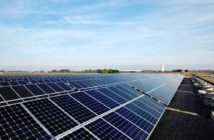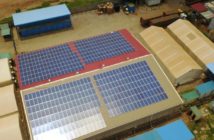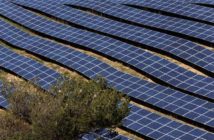CLEAN ENERGY AUTHORITY
Written by Chris Meehan
![]()
While last week’s solar news included the goings on at Intersolar NA plenty was going on outside. For instance, a major insurance company increased it’s offerings in the solar industry. That type of action will help as subsidies fade, as they’re doing in Germany where the market remains strong despite falling incentives. Meanwhile the market continues to expand worldwide. Morocco is moving forward on a strategy to ramp it’s domestic renewable energy use to 40 percent of its energy supply, from next to nothing and Wisconsin has introduced incentives for solar. Greenpeace asked for more commitments to renewable energy from Apple, even though the company just announced it would expand to 40 megawatts the size of its installation at its new flagship datacenter.
Greenpeace congratulated Apple last week as the company announced plans to make all its data centers 100 percent renewably powered and announcing that it would double the size of its solar installation at its flagship North Carolina datacenter. However, the environmental organization remains concerned about how the computer and wonder-gizmo company plans to reach that level.
The recent announcement that the Assurant Group partnered with GCube to offer insurance for photovoltaic projects will hopefully help reduce the risk associated with financing projects, which should help being the cost of financing for projects down. It’s just the latest firm to boost its insurance offerings for PV projects but it shows that insurance companies are warming to such projects.
Another thing that will help reduce the cost of financing projects is to move them from bank loans to low-risk investment funds. That’s what the new $282 million US Solar Energy Fund developed by Capital Dynamics is helping to do. The fund is investing in projects across the U.S. The fund is expected to produce returns in excess of 10 percent. By the time it’s completed funding projects it could support up to 100 photovoltaic arrays.
Both of these steps are important to supporting a vibrant installation market for solar, particularly as incentives for solar start to wane, as is occurring in the world’s largest solar market, Germany. However, despite falling incentives people continue to go solar. That’s because the county’s feed-in tariff has fallen below what customers pay for electricity there. But without the feed-in tariff customers may find that using their own PV power rather than feeing it back to the grid may now provide the richest incentive.
A little farther south than Germany, Morocco is moving forward with plans to become 40 percent renewably powered by 2020. That’s no small feat considering that the country now imports 90 percent of its energy. The country already is moving forward on the first phase of it solar plan and will soon announce who will install the country’s first utility-scale solar project, a 160-megawatt solar thermal project.
Wisconsin launched a new incentive package under recently passed legislation. The program is administered by Focus on Energy, a collaborative effort of the state’s utilities as required by the law. In all, the rate-payer funded program has $10 million to dole out for renewable energy technologies, with $2 million reserved for solar and $500,00 of that purely for residential solar. Starting in 2013, 75 percent of the fund will be dedicated to biomass, biogas and geothermal projects, with the remainder going to solar and wind technologies.
Solar thermal power often gets overlooked, but not at EchoFirst. The company’s focussed its efforts on developing hybrid PV, solar thermal systems and it’s latest, the Echo, is no different, and you can get it with no money down. This is likely the first time that a company is offering a combined PV and solar hot water system with no up front costs.






